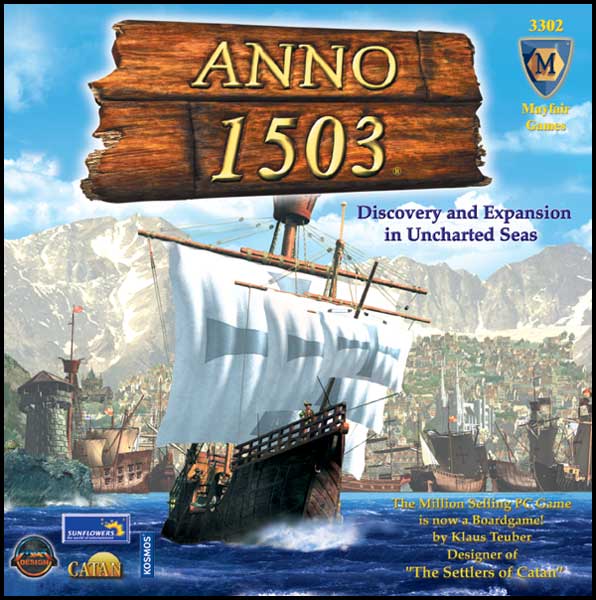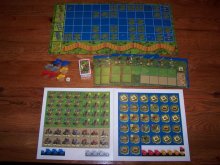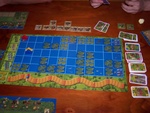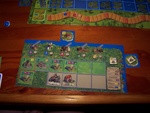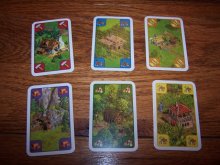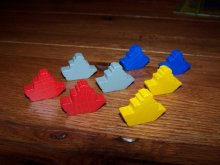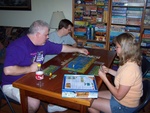
|
Anno 1503 A game by Klaus Teuber Published by Mayfair Games, Inc. and Kosmos Players: 2 to 4 Time: 60 minutes Reviewed by Susan Rozmiarek |
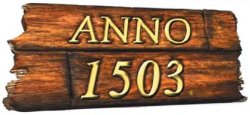
|
This is a new offering from the venerable game designer, Klaus Teuber. The game was published by Kosmos in Germany last year, and is finally being published by Mayfair Games in English. The game is based on a popular computer game of the same name. I haven't played the computer version, so I will not be able to compare whether or not the board version captures the feel of the PC version. I do find it both pleasing and amusing to see a board game spin-off of a computer game. Usually it is the other way around. Perhaps some new board gaming fans will be the result.
The theme of game is settling and developing islands. It is essentially a race between players to fulfill three out of five possible victory conditions. Winning requires careful resource management and the ability to adjust one's strategy as the game progresses. Included in the mix is a rather enjoyable building and exploration game.
Components:
As far as I can tell, the only difference between the two editions is the language of the text.
Otherwise, they both contain the same high quality components that I have come to expect from a Kosmos/Mayfair game.
These include:
- A four page color rulebook
- 1 Game Board
- 90 Commodity Cards
- 4 Home Island Boards
- 32 Island Tiles
- 28 Colonist Tiles (7 per player)
- 14 Public Building Tiles
- 16 Coat of Arms Markers (4 per player)
- Wooden Ships (2 per player)
- 1 Die
- A plastic insert customized to fit the components
Game play:
I have heard a fellow gamer, Ben Baldanza, aptly describe Anno 1503 as "Settlers of Puerto Entdecker."
Players familiar with those games will see the nuggets of resemblance in Anno 1503.
Present in a recognizable but altered form are the dice-rolling for resources from Settlers of Catan,
the exploration from Entdecker, and the building of specialized buildings from Puerto Rico.
However, the sum of Anno 1503's parts produces a feel all its own.
The main game board is placed in the center of the table. This depicts a water region with scattered facedown island tiles. Each player starts with one of his ships on the board, ready to sail forth and explore the islands. The board has a track to indicate how much gold each player possesses. Throughout the game, players will be spending and earning gold and making adjustments on this track. Also on the board is a box for each of the five victory conditions. Players will be placing tokens in these boxes to indicate that they have achieved that victory condition.
In addition to the main board, each player has a personal board representing his island. The board depicts several workshops, each with a corresponding commodity it will produce and the die roll that causes production. There are numerous piers circling the outer edge of the board to organize the player's Trade Agreement tiles and Outpost tiles that may be acquired by exploring islands. Each player also has a set of colonist tiles and the board has spaces for these as well as for public building tiles.
A player's turn consists of the following three actions, done in order:
- Roll for production
- Build, buy and/or sell commodities
- Explore
- Roll for Production:
The player rolls the die for production, with every player getting the commodity depicted on his
personal board for the resulting number rolled.
The commodity produced will be different for each player.
Commodities are represented by cards, which the players keep secret in their hands.
If the result is a six, a random event occurs.
Random events can be nasty. The die is rolled again and depending on the result, one of the following occurs:
- Pirate attack: Each player must pay one gold for each of his tiles on the outer edge of his board. If unable to pay, he loses a tile.
- Fire: Each player must pay one gold for every colonist not in the red safety zone. If unable to pay, he loses a colonist.
- Good Fortune: Breathe a sigh of relief as this result means every player gets to choose one free commodity of his choice.
- Build, buy and/or sell commodities:
The player now spends, builds, and buys and sells commodities in any order and as much as he can or chooses to do so.
- Building:
The building costs are shown on the player's board and include the cost, in commodity cards,
for building ships, colonists or promoting colonists to a higher level.
Colonist tiles are double-sided and depict different levels. They start out at the lowest level, a Pioneer, and can be promoted a level at a time to the highest and fourth level, Merchants. Each promotion has a different commodity cost. Note that having three Merchants is a victory condition. However, you have a limited number of tiles for each level. To build new Pioneers, you may have to promote the colonists already on the board to make Pioneer tiles available again.
New Pioneers are placed in order across the player's board. Starting with the third spot, there is a corresponding spot below it for Public Buildings. When a Pioneer is built on one of these spots, the player chooses any available Public Building and places it below the Pioneer for free. If a colonist tile is ever lost due to a fire, the Public Building below it is lost as well and goes back to the supply. Note: Having four Public Buildings is a victory condition.
There are several types of Special Buildings and the number of players determines the number of each type available. Each type is in very short supply and competition to get certain ones can be fierce. They include buildings that protect from pirates or fire, buildings that increase the amount a colonist will pay for a commodity, buildings that double the action points of ships, and a few others.
- Trading: Players can always buy up to two commodities per turn from the general supply for six gold each. This cost can be reduced with Trade Agreements. In addition, a player can sell commodities to his colonists. Each colonist is willing to buy one commodity per turn and the type of commodities and price is shown on the colonist tile.
- Building:
The building costs are shown on the player's board and include the cost, in commodity cards,
for building ships, colonists or promoting colonists to a higher level.
- Explore:
The last thing a player can do on his turn is to move his ships, if he has any, and explore islands.
Ships are built by spending the required commodities and a player may have up to two in play at any given time.
After being built, they start in a designated corner of the main board.
Each ship belonging to the player gets action points to spend equal to the number of players.
Moving one square orthogonally costs one action point.
If a ship is adjacent to an island, it can "explore" the island for the cost of one action point.
The player picks up the tile and secretly looks at it.
If he is not interested in keeping it, he puts it back and may continue to move his ship and explore
if he has any action points left.
If the player does decide to keep the tile, that ship's journey is over and it is returned to its
owner's supply, where it will need to be rebuilt again to use.
The player now places his new tile in the appropriate place on his personal island.
The island tiles are one of three types:
- New Outposts: These tiles show a commodity that can be produced. The player puts the new Outpost next to a gray pier running along the top of his island. Now, when the corresponding number is rolled, he can choose to take the resource from the workshop or the new Outpost. Getting an Outpost through exploration is the only way to acquire spice or tobacco from production rolls. Note: Getting four Outposts is a victory condition
- Trade Agreements: These are placed on an open brown pier running along the right hand side of a player's island. For each Trade Agreement a player owns, his cost of buying a commodity from the bank is reduced by one gold. There is space for a maximum of three Trade Agreements and this is also a victory condition.
- Treasure: These tiles are not placed anywhere, but are used and discarded immediately. There are two types. One lets the player promote a colonist for free, and the other gives the player 12 gold pieces.
The game progresses in this manner, slowly building and gaining speed until it ends immediately with a player achieving three of the five victory conditions:
- 3 Merchants
- 4 Public Buildings
- 3 Trade Agreements
- 4 Outposts
- 30 Gold
Much of the tension in the game comes about from the fact that all players in a game cannot meet several of the victory conditions. It can become a tight competition toward the end between players trying to fulfill the same ones. This is due to fact that certain types of tiles are limited. For example, it takes four Public Buildings to achieve that victory condition, but there are only 14 available in a four-player game. Outposts and Trade Agreements are limited as well.
Your strategy often develops from what Building Tile you are able to grab first. The Fire Brigade protects your colonists and public buildings from losses due to fires, so with its protection, you might put your efforts towards promoting colonists to the Merchant level and building Pioneers to fill the Public Building slots. Similarly, the Smith protects your island from pirate attacks, making it safe to collect Outposts and Trade Agreements. The Shipyard is really nice as it gives your ships double their normal actions each turn. There are lucrative islands that can help in fulfilling all of the victory conditions in some way. There are several strategies for earning gold in the game. Not only does gold fulfill a victory condition; it also buys the necessary resources for pursuing your other goals, and it protects you from pirates and fire.
There are plenty of checks and balances in the game to slow players down, along with multiple paths to achieve some of the goals. It is evident that the game was carefully playtested, as every aspect of the game seems to be quite balanced. But, just as in Settlers of Catan, it is possible for production die rolls to favor a particular player. Fortunately, this effect is less severe in Anno 1503, since all players always get a commodity of some sort unless a random event occurs. Still, if you dislike a dose of luck in your games, Anno 1503 may not be to your tastes.
There is another characteristic that will not be to the liking of some players. There is little to no direct player interaction. Players do not trade commodities with each other as they do in Settlers of Catan. You certainly must keep your eye on what other players are doing and adjust your own plans accordingly, but overall the game has a solitaire feel to it.
Summary:
Anno 1503 is an enjoyable game of resource management, building and exploration.
The game works equally well with three or four players, but I did not try it with two.
It is a pleasant reminder of some older, familiar games yet it captures a different feel with its own twists.
Players that like lots of player interaction are advised to steer clear, but despite the solitaire nature of play,
the game still feels competitive to me.
The careful planning needed should appeal to the more serious gamer,
while the healthy dose of luck makes the game accessible to family players.
While perhaps not as likely to have the widespread appeal of a few of his previous games,
Anno 1503 is nonetheless an excellent new offering by Mr. Teuber that I enjoy quite a lot.
| Other Web information: |
This page viewed
E-mail Ed Rozmiarek with questions or problems concerning this page.
Copyright © 2004, Ed & Susan Rozmiarek No portion of this website may be reproduced or copied without the consent of Ed or Susan Rozmiarek.
